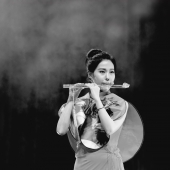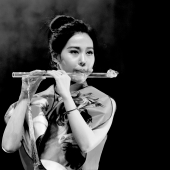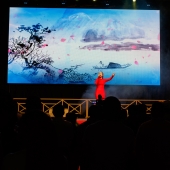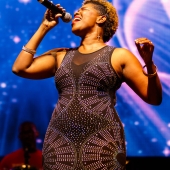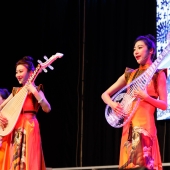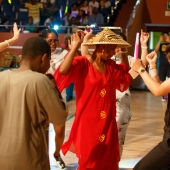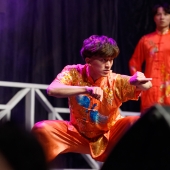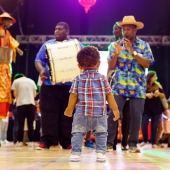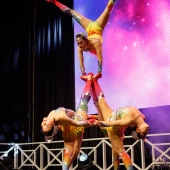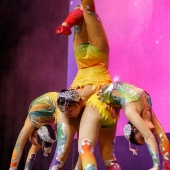One of the most popular events on the Chinese and Barbadian calender each year is the Fish and Dragon Festival held to celebrate the Chinese New Year.
The first Fish and Dragon Festival in Barbados was held in 2015 – The Year of the Ram.
The first edition of the festival was sponsored by the Central Bank of Barbados and the Embassy of the People’s Republic of China in Barbados. And today, the festival continues.
On January 30, 2019, Barbados celebrated the fourth anniversary of the Fish and Dragon Festival, where Barbadians, including several hundred school children, streamed into the Gymnasium to enjoy and experience Chinese art, entertainment and food.
This year – the Year of the Pig - saw special guests the charming Beijing-Tianjin-Hebel Performing Arts Troupe entertain the crowds. The Barracks Hill Stilt Walkers, the Tuk Band, Shaggy Bears and the Allamby Black Tigers were also part of the 2019 Festival.
BACKGROUND
The festival, conceived and created by Tonika Sealy, explores synergies between the Chinese New Year - usually in February – and the celebration of Black History Month in Barbados, and creates a dialogue with Chinese culture where Barbadians were true co-creators of that encounter.
Ms. Sealy’s idea was to showcase the full breadth of Chinese culture including food, martial arts, healing, décor, dance, music, etc. Equally, she aimed to display the real genius amidst the full flourishing of Barbadian arts and cultural practices.
Other goals included highlighting the history and presence of Caribbean Chinese peoples and extending our notion of a creolized society that would include the presence of Chinese students, businesses and visitors in Barbados, and that of Bajan students and entrepreneurs in China. Finally, Sealy wanted this new social and cultural imagination to generate ideas of generosity and hospitality as part of building social empathy and contributing to a new national consciousness in Barbados.
THE FIRST FESTIVAL
The first festival, held in 2015, encompassed a number of different events and fora, in addition to the festival stage and booths. It was the Year of the Ram, and that was celebrated. The Ram is known for appreciating the finer things in life, and culinary, healing, martial, visual and performing arts were all included in the first programme. One of the highlights that year was the screening of ‘Under the Moon’ and ‘Chinee Girl’ – two films from Trinidadian Chinese directors.
The latter film included frank confrontations with some of the cultural and social prejudices affecting women of Chinese descent in contemporary Trinidadian society.
‘Herbal Dialogues’ were created in which Barbadian-African herbal healers were paired with traditional Chinese medicine doctors for discussions and demonstrations. In so doing the organisers hoped to honour both the local traditions of healthy living and to value Chinese traditional medicine. Both traditions were allied in offering a democratic and holistic alternative to the high technology and commercial pharmacology of Western medicine.
In the art and photography exhibition‘Visualizing China’, Sealy worked with Barbadian curator Oneka Small, as she curated works by Bajan artists that spoke to the question of what makes a free society, alongside works selected through the Chinese embassy.
A large audience watched the culminating concert on the main festival stage featuring the Tianjing Cathay Future Children’s Group.
THE 2016 FESTIVAL
Building on the success of the 2015 festival, the goal in 2016 was to bring even greater attention to cultural and artistic interchanges and synergies between China and the Caribbean, creating a more ambitious event on the national calendar of celebrations.
The second festival celebrated the Year of the Red Fire Monkey. The theme was ‘Journey to the East’ based on the title of the most famous saga of the monkey figure in Chinese cosmology. In keeping with the character of the monkey, the ideas of ‘play,’ ‘innovation,’ ‘magic,’ and ‘technology’ were celebrated.
The second festival was much more ambitious, with additions like the gaming exhibit and the participation of the world- famous Chinese National Opera and Dance Drama Theatre (CNODDT). This festival attracted coverage by CCTV, the Chinese national television network, which is now part of the global China National Television Network, CGTN.
The Gala performance featured the Chinese National Opera, local folk-singing legend Emile Straker and classical Chinese music sensation Cao Xue. Audiences at the Cultural Extravaganza had the pleasure of seeing such acts as the UNESCO-awarded piece ‘Maafa’ by the Israel Lovell Foundation, numerous martial arts, acrobatics, and musical acts from both China and Barbados, as well as six pieces from the Chinese National Opera. The event was both well attended and heavily covered in both conventional and social media.The Year of the Monkey celebration also saw a much larger roster of exhibitors, a Wellness Village sponsored by the Barbados China Cultural Centre, and a competition to win a trip to China called ‘Journey to the East.’
In that year, Ms Sealy also curated an art exhibition, featuring young and upcoming Barbadian artists and themed around the Year of the Monkey.
In Chinese culture the monkey is most famously portrayed through the story of the Monkey King, or Sun Wukong. As a lead character in one of the classic texts of Chinese literature, Journey to the West, Sun Wukong has many qualities Barbadians would recognize in a storied creature with human intelligence and sentiments.
The Monkey King is first and foremost what we would call a trickster. The figure of the trickster is one who often outwits stronger opponents and in the case of Sun Wukong he goes up against a Dragon King and even the Jade Emperor in Heaven with his fearlessness and clever tactics. In the Caribbean we also have our tricksters and rebels, and as with China, they are far more than just characters from stories. Anansi and Compere Lapin (Bre’r Rabbit) in the French-speaking Caribbean are key trickster figures brought from African culture. Anansi, the spider who often takes the shape of a man, is an important figure shared by number of African peoples, most prominently the Ashanti and Akan cultures.
Then there is our own monkey in Barbados. Known for stealing crops, or entertaining tourists, only his appearance with Shaggy Bear and Mother Sally in our Tuk band tradition reminds us that he too may have had significance as a trickster.
In the Caribbean we have our own relationship to the figure of the monkey. After two years of directing the festival Ms. Sealy moved on and left the festival in the capable hands of a special committee headed by Adisa Andwele who promises to continue the festival and share the tremendous opportunities and responsibilities for the bilateral cultural and artistic relations with China.
